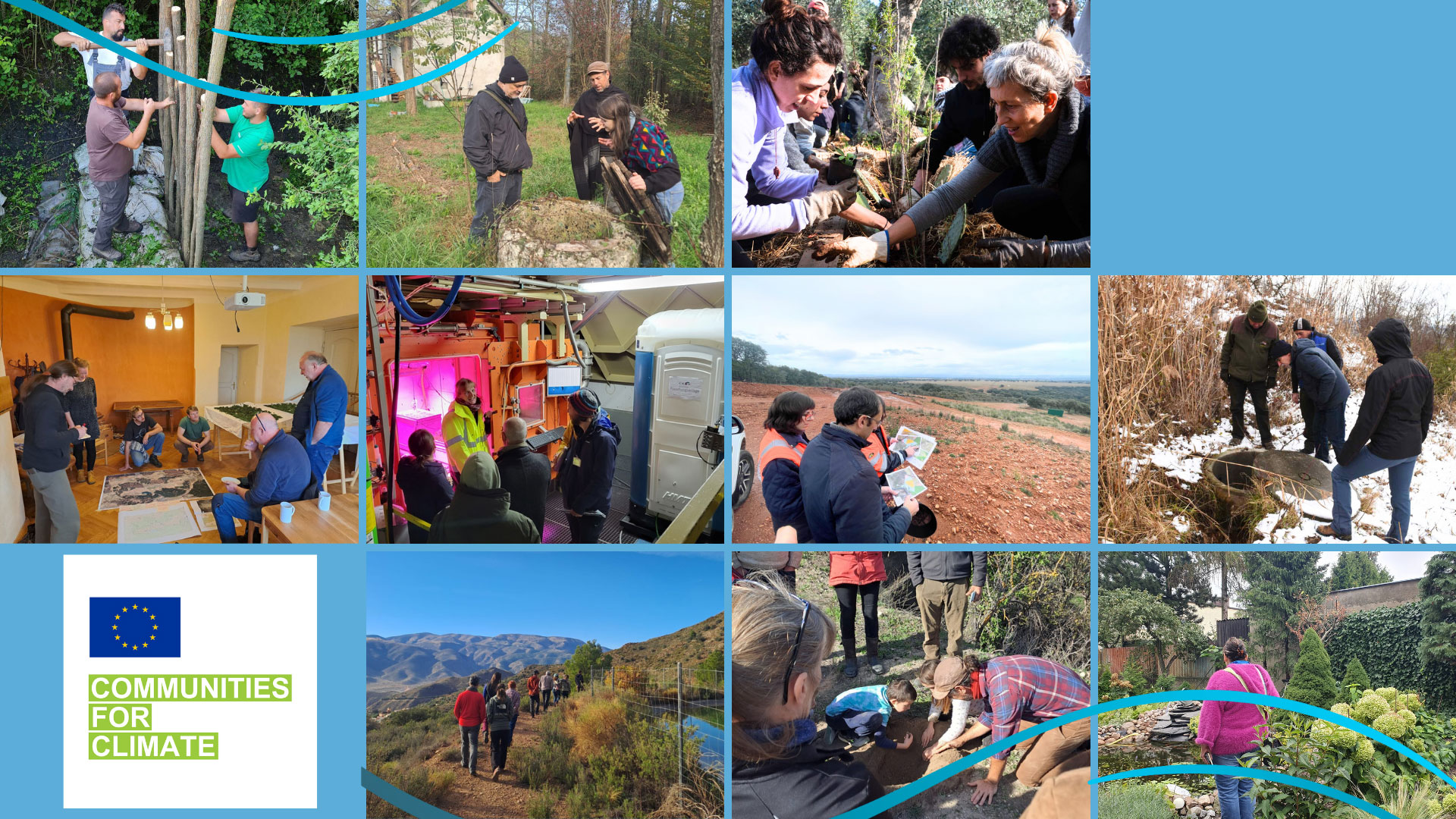Communities Leading the Way on Water Resilience
- 30 Apr 2025

Across Europe, the climate crisis is dramatically reshaping how we think about one of our most vital resources: water. Droughts, floods, and degrading ecosystems threaten not just our landscapes and agriculture but the very fabric of our communities. In this context, water management is not just a technical or institutional concern but an urgent, collective responsibility. This is also why, EVP Fitto made water resilience a priority in the modernised cohesion policy that followed the policy’s mandatory mid-term review this year. The measures announced on the 1st of April allow member states to reprogramme funding on urgent water management projects. The modernised cohesion policy also includes incentives for member states that choose to redirect funds towards the newly established priorities, including water management.
Ahead of the policy changes, communities across Europe, have been taking action to address the water challenges that affect them most closely. This article explores how Communities for Climate (C4C) are dealing with drought, floods and degraded soils through grassroots innovation, cross-border cooperation, local wisdom, and regenerative land management.
Tackling water scarcity through local wisdom
In many regions, surface waters are disappearing, and groundwater levels are sinking to unprecedented lows. This is particularly felt along the Hungarian-Romanian border, where droughts are a worrying reality in the Bihor-Kis-Sárrét region. The Balanced management of water resources project seeks to reverse this trend through improved governance of the Sebes-Körös river and other smaller cross-border watercourses.
“Water knows neither municipal nor national borders,” says Csaba Vaszko, one of the project’s representatives. “With the help of C4C, we have established a catchment community and started thinking together at the catchment level on both sides of the border.”
By bringing together municipal leaders, farmers and water experts from nine municipalities, the project has fostered a truly integrative approach. Solutions have focused on water retention and flow regulation—not only on public lands but also on private agricultural plots—showing how multi-stakeholder collaboration is essential for building long-term resilience.
As C4C’s community facilitator, Tracey Wheatley (Transition Wekerle), notes, these conversations have sparked both technical and cultural renewal: “A grassroots-initiated common statement was signed, giving a framework for continued cooperation.” In the community of Kötegyán, cultural events, visual storytelling, and discussions have helped residents of all ages explore their role as water stewards.
More than three thousand kilometres west, in Andalusia (Southern Spain), the Almócita en Transición community connects water management with social regeneration. Facing both depopulation and climate pressure, residents have created communal gardens and are now working on a local species nursery to support forest regeneration and water conservation.
“Nature-based solutions have been successfully proven,” argue experts Aline Van Moerbeke and Juan Pedro Franco (La Casa Integral). “All interventions are based on reading the whole system context: soil, vegetation, topography, and water cycles. We can turn this problem into a solution, by working with nature, not against her.”
Droughts, floods, and the forgotten knowledge of Water Cycles
In the mountainous terraces of Vélez Blanco, still in Andalusia, water is available but fragile. It springs from the nearby Sierra María, yet overall precipitation is declining, leading to loss of forest cover and drying soil. The Agroecology School project aims to halt this decline by reviving traditional practices and introducing regenerative land use strategies.
“The key is restoring the small water cycle,” says Jean-Pierre Vercruysse, a development expert with Directorate for Regional and Urban policies at the European Commission, who visited the project. “Agroecology brings together ancient local knowledge and regenerative agriculture, enhancing soil’s ability to retain moisture and feed ecosystems.”
The initiative has become a local movement, with farmers, families, and professionals attending the project’s kick-off: the Water Conference, and learning from maturer projects like Sunseed and Oasis Al Hamam. “We’ve created a network of people concerned and motivated about climate change mitigation,” shares project leader, Nadia Jessen. “Our topography is special, and all local research shows that vegetation cover, humus-rich soils, and greywater recycling are our best tools to retain water.”
In Liguria (Italy), extreme weather events have taken a different shape—from droughts to flash floods—and are eroding soil and threatening the hydrological cycle. L’acqua si Pianta! responds with a powerful message: water can be planted. Through reforestation, rainwater harvesting, and agroecology, residents are restoring local ecological balance.
“The most magical moment was witnessing how, in just four days, 15 people reshaped a landscape,” recalls Elisabeth Masneri, project representative. “They created a swale, planted 50 trees, and built an infiltration pond. These simple acts helped restore water to the land and hope to the community.”
Landscapes of cooperation: Rebuilding trust, water and soil
In the village of Daia, in Romania, soil erosion on common pastures has become a visible sign of environmental and social stress. The local Romanian climate adaptation pilot is developing a nature-based water retention strategy and blending traditional wetland restoration with modern agroecological practices, such as no-till farming and buffer strips.
Crucially, this project is not only about techniques but about trust. “C4C support helped accelerate cooperation between local decision-makers and the community,” explains Szilvia Bencze, the project’s representative. “Our facilitators helped people open up, share doubts, and engage with the process. This is the foundation for real change.”
This idea that community and landscape regeneration must go hand in hand also animates the Rainwater Legacy project in Poland, where drought is an increasing threat. Through workshops and awareness raising campaigns, residents of Gniezno and Poznan learned how simple actions, like creating rain gardens or storing rainwater, can dramatically shift local resilience.
“We managed to gather many people for whom cooperation with the forces of nature is very important,” says Monika Józefczyk. “We hope our work changes, at least a little, how people think about water.”
Similarly, in Southern Italy, the Syntropic oasis to RE-connect aims to create a resilient and biodiverse ecosystem within an ecovillage through regenerative practices. By teaching simple and practical techniques, the relationship between the project and surrounding communities, including farmers has been strengthened.
Circular and systems-thinking for Water
In Germany, communities are exploring slightly different angles on water management, namely on wastewater reduction. The Use Less Water! project replaces conventional sanitation systems with dry separation toilets. According to the community representative, Joris Spindler, the experience has shown how “the direct use of nutrients from urine can contribute to a very short nutrient cycle with very little energy input.” By composting human waste, this project exemplifies circular economy principles while dramatically cutting water consumption.
Following circularity, in Central Southern Spain, the Local Action Group (LAG) Valle de Alcudia has initiated a participatory approach to address Sustainable water management from a tungsten mining project in Abenójar. The project has focused on improving water quality, treating and reusing wastewater from the mine for farming and supporting cinegetic species, for instance.
Talvolk, another German community, is restoring water cycles across 2,000 hectares of landscape. Through climate-adapted forest and field management and public engagement via hikes and cultural events, Talvolk demonstrates the power of landscape-scale water regeneration rooted in both ecology and community.
A shared flow: Learning from communities
While each of these community projects responds to local challenges, they are united by a core principle: sustainable water management must be inclusive, community-driven, and adapted to local conditions. Whether tackling drought, erosion, or outdated infrastructure, communities are redefining resilience. Innovation does not always mean high-tech solutions. Often, it begins with people sitting together—residents, farmers, mayors, engineers, and schoolteachers—simply talking about water until great ideas float to the surface.
The momentum continues. The next and final two articles of this series will explore how communities are reconnecting with nature and restoring biodiversity through projects that are often very linked to water. After all, healthy rivers and wetlands feed forests and meadows. Biodiversity and water resilience are two sides of the same coin. Stay tuned and watch this space, as we dive deeper into Europe’s green transition, where local knowledge meets climate action and where collaboration flows from the ground up.


